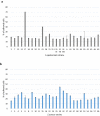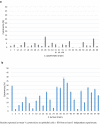Evaluation of the role of staphylococci in the pathomechanism of conjunctivitis
- PMID: 33778922
- PMCID: PMC8238708
- DOI: 10.1007/s10792-021-01818-w
Evaluation of the role of staphylococci in the pathomechanism of conjunctivitis
Abstract
Purpose: Determination of the association between ica genes and phenotypic biofilm formation in staphylococcal isolates involved in conjunctivitis, their antibiotic resistance as well as detection of selected virulence characteristics: adhesion to epithelial cells and in vitro cytotoxicity.
Methods: The study included 26 Staphylococcus aureus (SA) and 26 Staphylococcus epidermidis (SE) isolates. The presence of icaAD genes and ica operon was determined by the PCR assay. Phenotypic biofilm formation was verified using the microtitre plate assay. Antibiotic resistance was performed using the disc diffusion method. Staphylococcal ability to attach to host cells was assessed by flow cytometry. Cytotoxicity on epithelial cells was evaluated by LDH assay.
Results: The ica genes were detected in 26.9% of SE and in 42.3% of SA isolates. Only 15.3% of isolates (SE) were positive for both the icaAD and the ica operon. Phenotypically, 19.2% of SE isolates were strong biofilm producers, among which three were both icaAD- and ica operon-positive. About 26.9% of SA isolates were strong biofilm producers. Methicillin resistance (MR) was detected in 34.6% of SE and 26.9% of SA isolates. About 75% of MR isolates were multidrug resistant. SA isolates adhered to host cells more extensively than SE. SA isolates released higher level of LDH than SE.
Conclusions: Adherence abilities were commonly observed in staphylococci associated with conjunctivitis. However, low prevalence of isolates positive for a complete and functional ica locus and low prevalence of strong biofilm producers was detected. SA adhered to a greater extent to eukaryotic cells than SE and were more cytotoxic.
Keywords: Adhesion; Biofilm; Conjunctivitis; Cytotoxicity assay; Drug-resistance; Staphylococcus.
Conflict of interest statement
All authors certify that they have no affiliations with or involvement in any organization or entity with any financial interest (such as honoraria; educational grants; participation in speakers' bureaus; membership, employment, consultancies, stock ownership, or other equity interest; and expert testimony or patent-licensing arrangements), or non-financial interest (such as personal or professional relationships, affiliations, knowledge or beliefs) in the subject matter or materials discussed in this manuscript.
Figures






Similar articles
-
High level of persister frequency in clinical staphylococcal isolates.BMC Microbiol. 2022 Apr 21;22(1):109. doi: 10.1186/s12866-022-02529-7. BMC Microbiol. 2022. PMID: 35448965 Free PMC article.
-
Biofilm forming multi drug resistant Staphylococcus spp. among patients with conjunctivitis.Pol J Microbiol. 2010;59(4):233-9. Pol J Microbiol. 2010. PMID: 21466040
-
Epidemiology, Drug Resistance, and Virulence of Staphylococcus aureus Isolated from Ocular Infections in Polish Patients.Pol J Microbiol. 2019 Dec;68(4):541-548. doi: 10.33073/pjm-2019-056. Epub 2019 Dec 5. Pol J Microbiol. 2019. PMID: 31880897 Free PMC article.
-
Biofilm formation of methicillin-resistant coagulase negative staphylococci (MR-CoNS) isolated from community and hospital environments.PLoS One. 2017 Aug 31;12(8):e0184172. doi: 10.1371/journal.pone.0184172. eCollection 2017. PLoS One. 2017. PMID: 28859149 Free PMC article.
-
Correlation Between Biofilm Formation and Antibiotic Resistance in MRSA and MSSA Isolated from Clinical Samples in Iran: A Systematic Review and Meta-Analysis.Microb Drug Resist. 2020 Sep;26(9):1071-1080. doi: 10.1089/mdr.2020.0001. Epub 2020 Mar 10. Microb Drug Resist. 2020. PMID: 32159447
Cited by
-
Prevalence of icaADBC genes, and correlation with biofilms and antibiotic resistance in S. aureus: a systematic review and meta-analysis.Germs. 2024 Dec 31;14(4):387-401. doi: 10.18683/germs.2024.1448. eCollection 2024 Dec. Germs. 2024. PMID: 40271090 Free PMC article.
-
Comparative Analysis of Bacterial Conjunctivitis in the Adult and Pediatric Inpatient vs. Outpatient Population.Microorganisms. 2025 Feb 20;13(3):473. doi: 10.3390/microorganisms13030473. Microorganisms. 2025. PMID: 40142365 Free PMC article.
References
-
- DeCory HH, Sanfilippo CM, Proskin HM, Blondeau JM. Characterization of baseline polybacterial versus monobacterial infections in three randomized controlled bacterial conjunctivitis trials and microbial outcomes with besifloxacin ophthalmic suspension 0.6% PLoS ONE. 2020;15(8):e0237603. doi: 10.1371/journal.pone.0237603. - DOI - PMC - PubMed
-
- Florez-Páez LA, Zenteno JC, Alcántar MD, Vargas-Mendoza CF, Rodríguez-Martínez ME, Jan-Roblero J, Cancino-Diaz JC. Molecular and phenotypic characterization of Staphylococcus epidermidis isolates from healthy conjunctiva and a comparative analysis with isolates from ocular infection. PLoS ONE. 2015;10(8):e0135964. doi: 10.1371/journal.pone.0135964. - DOI - PMC - PubMed
MeSH terms
Substances
LinkOut - more resources
Full Text Sources
Other Literature Sources
Medical
Molecular Biology Databases
Miscellaneous

